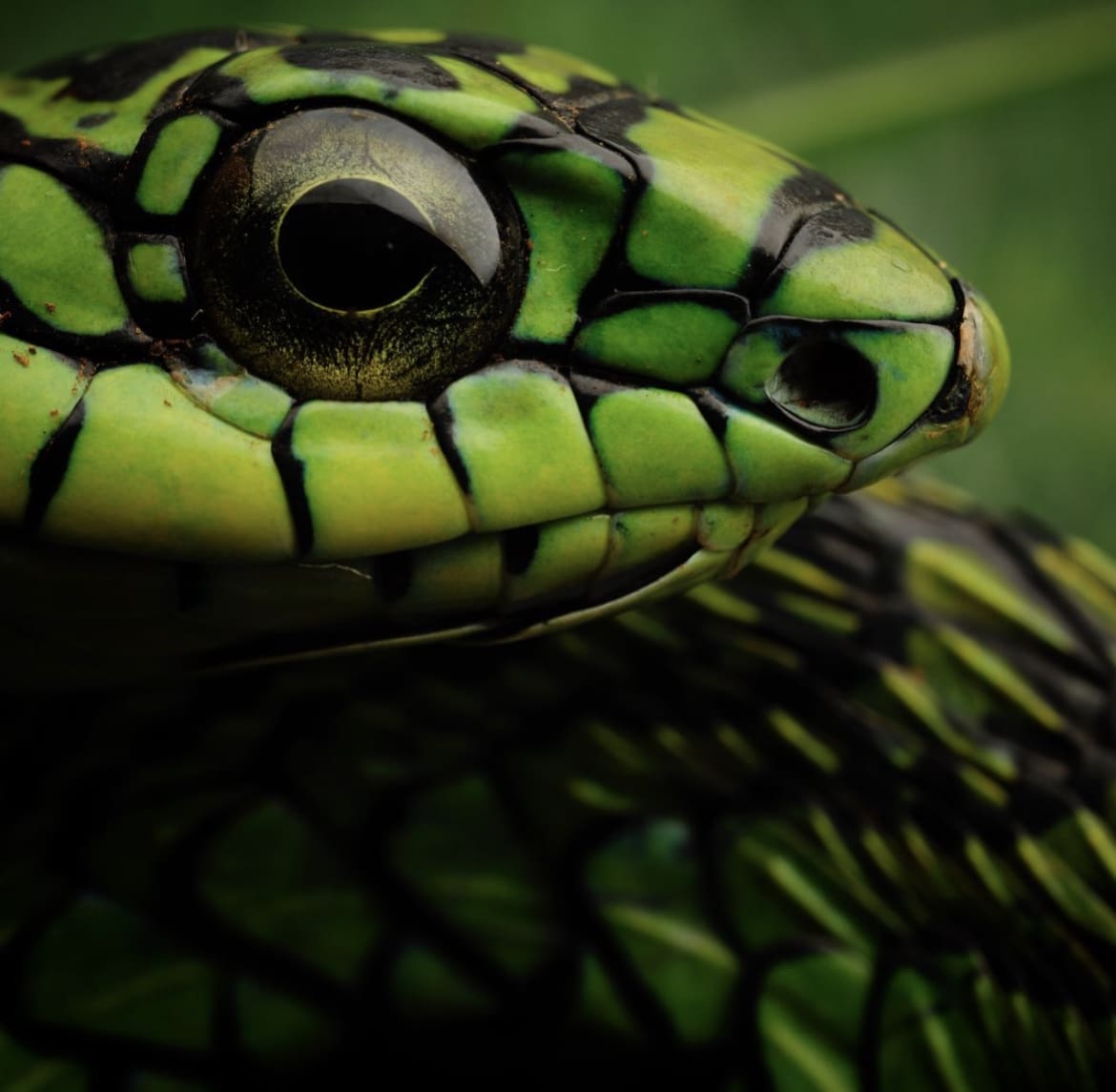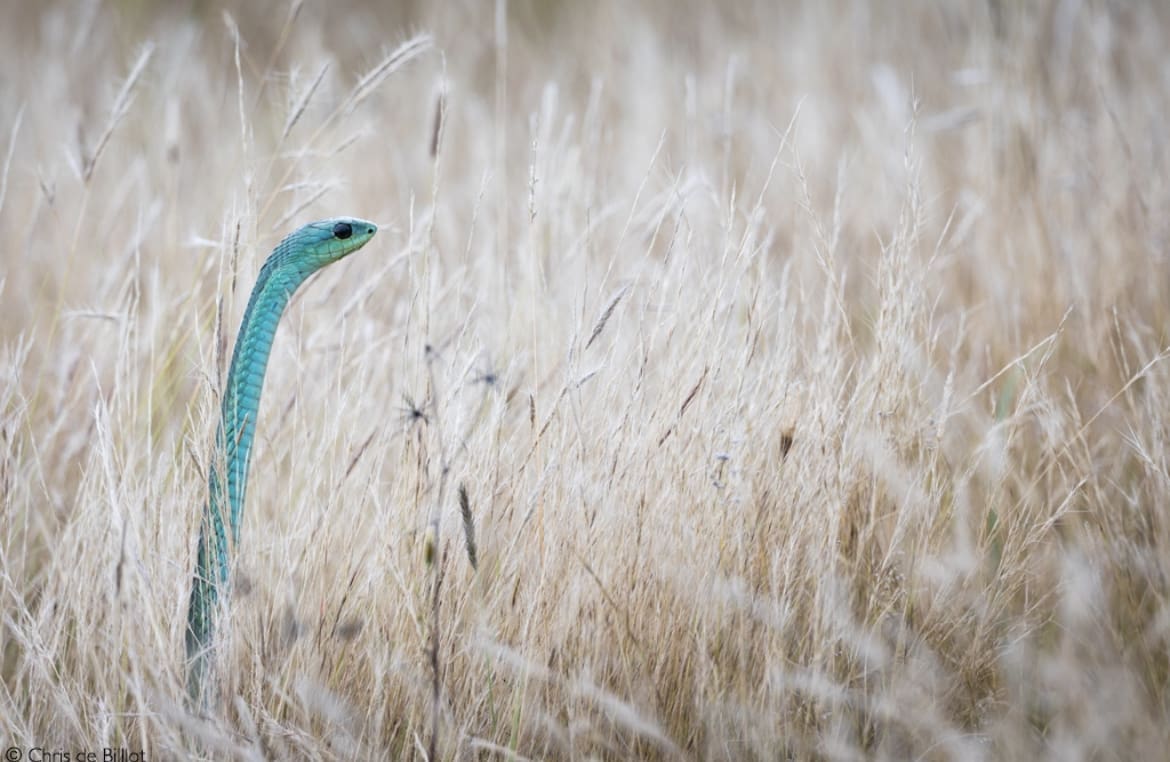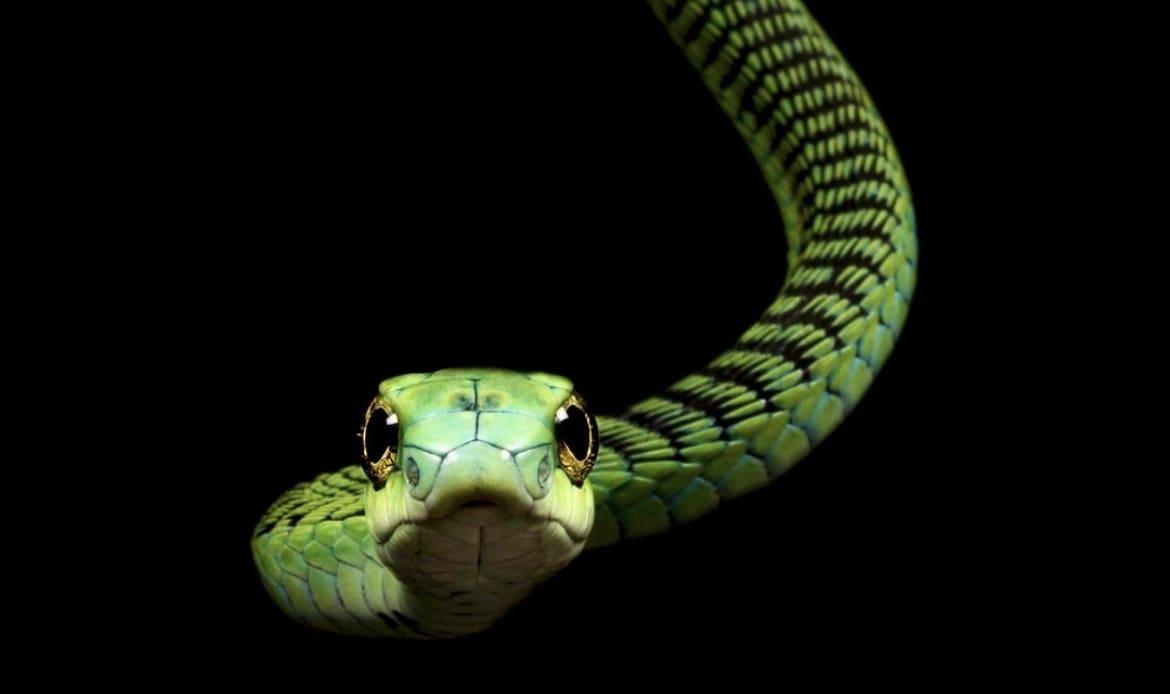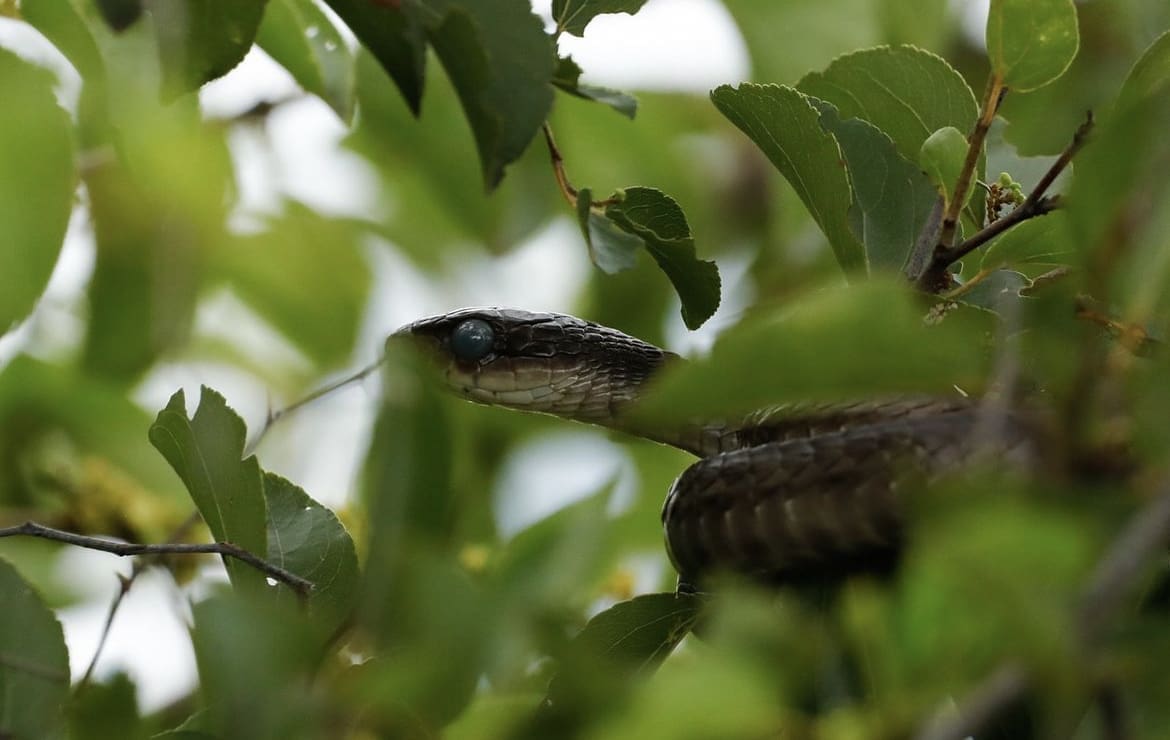This isn’t your garden-variety serpent; the Boomslang is a creature of mystery, myth, and a dash of danger, all wrapped up in a vibrant package.
Let’s dive deep into the life of this fascinating reptile, designed especially for the urban millennial who thrives on the thrill of discovery.
What is the Boomslang?
The Boomslang (Dispholidus typus), for those who haven’t had the pleasure of an introduction, is more than just a snake with a cool name that sounds like it came straight out of a comic book. This slithery fellow is a member of the Colubridae family, which might not mean much to you right off the bat, but stick with me.
Unlike the typical villain in snake stories, the Boomslang has a certain allure – it’s the James Dean of the serpent world, if you will. Native to sub-Saharan Africa, this snake is not just roaming the savannahs; it’s dominating the treetops, living its best life among the branches. Why the name “Boomslang,” you ask? Hailing from Afrikaans/Dutch, it means “tree snake,” which, spoiler alert, is a dead giveaway to its arboreal lifestyle.
What Do Boomslangs Look Like?
Picture this: a sleek, slender body gliding through the trees. The Boomslang is a masterpiece of evolution with a distinctive look that sets it apart from its earthbound cousins. First off, these snakes come in a variety of colors, but they’re not just doing it for the fashion statement. The males are usually dressed in a vibrant green with some showcasing blue or yellow hues, making them the life of the arboreal party. Females, on the other hand, prefer a more understated brown or olive, proving that in the snake world, subtlety has its own appeal.
But it’s not just the color that catches the eye; it’s their size and features. Boomslangs can stretch up to 5 feet long, though they’re more often found lounging at around 3 to 4 feet. They have this distinctively large head and those eyes – oh, those eyes! Large, round, and inquisitive, their eyes are like windows into the soul, if you believe snakes have souls, that is.
These aren’t just for show; they give the Boomslang excellent vision, which is pretty handy when you’re hunting from the treetops.

How Big Are Boomslangs?
When we talk about size, the Boomslang might not be the titan of the serpent world, but it’s no slouch either. Averaging between 3 to 5 feet, as we mentioned, these snakes strike a balance between being long enough to command respect and agile enough to navigate the complex canopy highways of their habitats.
It’s like they’re custom-built for the life above ground, combining grace, power, and precision in one slender package. For our metric friends, that’s about 100 to 160 cm of snake, give or take.
Boomslang Skin
Let’s talk about that fabulous outfit it’s always sporting. The skin of a Boomslang is not just about looking good; it’s a crucial survival tool. Covered in scales that shimmer in the sunlight, the skin serves multiple purposes, from camouflage to protection from the elements. This isn’t your average snake skin; it’s a sophisticated suit of armor, designed for stealth and durability.
The scales themselves are keeled, giving the Boomslang a matte finish, perfect for blending into the dappled light of its leafy abode. It’s this unique skin that allows the Boomslang to slither through life relatively unnoticed, save for the keen eyes of those who know where to look.
Boomslang Eyes
And speaking of eyes, remember those distinctive peepers we touched on earlier? There’s more to them than meets the eye (pun absolutely intended). The Boomslang’s vision is among the best in the snake world, allowing it to spot movement and detail from a distance. This exceptional eyesight is a game-changer in the treetops, enabling it to hunt with precision.
The large, binocular-style vision means they can judge distances accurately, essential for navigating the complex canopy and striking at prey with lethal accuracy. In a world where a miss could mean going hungry, the Boomslang’s eyes are its most prized possession.

Boomslang Colouration
Now, onto the Boomslang’s most striking feature – its color. We briefly mentioned the vibrant greens of the males and the more subdued tones of the females, but there’s a whole palette at play here. Depending on their age, sex, and even the specific region they hail from, Boomslangs can range from bright green to brown, and even sometimes a dusky grey.
This isn’t just for show; it’s an evolutionary masterpiece of camouflage. Imagine a predator, scanning the trees for its next meal, or a prey, wary of the shadows. In both cases, the Boomslang’s coloration allows it to either avoid becoming someone’s snack or sneak up on its own.
The green males, often found sunning themselves among the leaves, blend in so well they can be nearly invisible to the untrained eye. On the flip side, the browner females meld into the branches and the trunk, making them equally elusive. This color variation isn’t just a random roll of the genetic dice; it’s a carefully honed trait that gives the Boomslang its edge in the wild.
What Does the Boomslang Eat?
Boomslangs are discerning diners with a taste for the aerial buffet that their habitat provides. Their diet mainly consists of small vertebrates, including birds, bird eggs, frogs, chameleons, and other lizards. Occasionally, they might indulge in a small rodent or two, proving their adaptability and opportunistic feeding habits. Their hunting strategy is as fascinating as it is effective. With their precise vision, Boomslangs can spot a potential meal from a distance, approach with stealth, and strike with accuracy.
They’re not just hunters; they’re snipers of the snake world. The venom, potent and hemotoxic, immobilizes their prey quickly, ensuring a meal well secured. This diet reflects the Boomslang’s role in the ecosystem as a regulator of small vertebrate populations, showcasing their importance beyond just their venomous bite.

Boomslang Social Structure
If you’re picturing Boomslangs throwing treetop parties and socializing like it’s the reptilian equivalent of a Friday night, you might be slightly off mark. Boomslangs are solitary creatures, coming together only for mating. This isn’t to say they don’t have a social structure; it’s just more about personal space and less about social gatherings.
Their territories can overlap, but interactions are minimal, reflecting a lifestyle that prioritizes independence and survival over social bonds. This solitariness also plays into their hunting strategy, as being lone hunters allows them to efficiently manage their energy and resources without competition from their kind.
How Do Boomslangs Reproduce?
When it comes to reproduction, the Boomslang’s approach is as straightforward as their solitary lifestyle suggests. They are oviparous, meaning the females lay eggs rather than giving birth to live young. The mating season brings males and females together briefly for the dance of creation, after which they part ways, with the female going off to lay her clutch of eggs in a safe, hidden location. A single clutch can contain anywhere from 10 to 25 eggs, which the female leaves to incubate naturally. After about two to three months, the eggs hatch, and the young Boomslangs emerge, fully independent and ready to take on their leafy world. These miniatures of the adult Boomslangs are born equipped with venom, making them capable hunters from an early age.
Reproduction in the Boomslang world is a testament to the resilience and self-reliance of these serpents. With minimal parental involvement, the young snakes are a striking symbol of nature’s emphasis on survival and adaptability. The cycle of life for the Boomslang, from the solitary hunter to the brief union for reproduction, underscores the intricate balance of independence and continuation of the species in the wild.

How Long Do Boomslangs Live?
Boomslangs, in the grand tapestry of nature, have a moderately lengthy tenure in the wild. With the right mix of luck, stealth, and a diet rich in nutrients, these serpents can live up to 10-15 years. In captivity, with threats significantly reduced and meals served on a regular, predictable schedule, they’ve been known to stretch their lifelines even further, sometimes reaching beyond 20 years.
This longevity is testament to their robust design and adaptability, navigating the challenges of predators, disease, and competition with a resilience that’s as admirable as it is fascinating. For the Boomslang, every year is a journey of survival, a testament to their prowess and the intricacies of their ecosystem.
Is the Boomslang Aggressive?
Now, onto a question that might be prickling at the back of your mind: Does their venomous bite make them ticking time bombs of aggression in the treetops? The answer is not as straightforward as one might think. Boomslangs are, by nature, shy and elusive. They prefer the high road, quite literally, avoiding confrontation by blending into the leafy canopy.
Their first instinct when faced with a potential threat is to flee rather than fight. However, like any creature cornered or feeling threatened, they can become defensive. It’s important to note that Boomslangs will not go out of their way to attack humans. Most bites occur when people try to handle or provoke them. So, while they are equipped with a potent venom, they are not aggressive by default. Respect their space, and they’ll happily extend the same courtesy.
Are Boomslangs Territorial?
Given their solitary nature, one might wonder if Boomslangs are fiercely territorial. The truth is, while they do have preferred ranges where they hunt and live, they’re not as territorial as some of their serpent kin. Their territories can overlap with those of other Boomslangs without much issue.
This isn’t to say they welcome company with open coils; they simply tolerate the presence of others in their space, as long as resources are abundant and competition is minimal. This tolerance allows for a certain fluidity in their social structure, a nod to the complex balance of coexistence in the wild. Boomslangs, with their arboreal lifestyle, have adapted to a life where space is shared, not contested fiercely.

How Fast Are Boomslangs?
When it comes to speed, Boomslangs might not be the first to cross the finish line if pitted against some of the ground-dwelling speedsters of the snake world. However, in their arboreal realm, they exhibit a grace and agility that’s unmatched. Their movement through the trees is fluid and assured, a slow, deliberate dance among the branches.
This isn’t to say they can’t pick up the pace when necessary. When threatened or on the chase, they can move with surprising speed, darting from point A to B with the precision of a skilled acrobat. It’s this blend of poise and potential for swift movement that makes the Boomslang a master of its treetop domain.
Can Boomslangs Kill People?
The question of whether Boomslangs can kill people is one wrapped in fear, fascination, and often, misinformation. Yes, the Boomslang possesses a potent hemotoxic venom that can be fatal to humans if not treated promptly. This venom disrupts the blood’s ability to clot, leading to serious internal bleeding.
However, fatalities are extremely rare, thanks in part to the Boomslang’s reserved nature and the efficacy of antivenom treatments available today. Bites are uncommon because Boomslangs are elusive and prefer to avoid human interaction. Most incidents occur when individuals attempt to handle or provoke the snake. So, while the Boomslang does have the capacity to be lethal, understanding and respecting their nature greatly minimizes the risk they pose.
Where Do Boomslangs Live?
The Boomslang’s choice of residence is as varied as its diet, showcasing an impressive adaptability to different environments. These snakes are primarily found throughout sub-Saharan Africa, making their homes in a variety of habitats ranging from the dense forests to the more sparse savannahs and even semi-arid regions.
Their preference for the trees does not limit them to the thick, jungle-like areas; they are equally at home in bushveld, scrub, and sometimes, the outskirts of human habitation where trees provide the necessary canopy for their arboreal lifestyle. This wide range of habitats not only highlights the Boomslang’s adaptability but also underscores the importance of diverse ecosystems in supporting the myriad life forms that depend on them.

How Many Boomslangs Are There in the Wild?
Quantifying the exact number of Boomslangs in the wild is a challenge, akin to counting shadows in a dense forest. These snakes are masters of camouflage, and their secretive, arboreal nature makes them difficult to study. However, despite the lack of precise numbers, the Boomslang is currently not considered endangered.
They are thought to be relatively common within their extensive range across sub-Saharan Africa, but like many species, they face pressures from habitat loss and human encroachment. Monitoring their populations is essential for understanding trends and ensuring that their status remains stable, allowing these mesmerizing creatures to continue thriving in their natural habitats.
Are Boomslangs Endangered?
As of now, the Boomslang is not listed as endangered. It enjoys a “Least Concern” status on the IUCN Red List, thanks to its widespread distribution and presumed large population. However, this status should not lead to complacency. The Boomslang’s habitat is under increasing threat from deforestation, agricultural expansion, and urban development.
These environmental pressures could pose significant challenges to the Boomslang’s survival, highlighting the need for ongoing conservation efforts to preserve the natural landscapes that these snakes, and countless other species, depend on for their survival.
Threats to Boomslangs in the Wild
The primary threats facing Boomslangs are habitat destruction and the degradation of their natural environments. As humans continue to expand their footprint, the lush forests and savannas that Boomslangs call home are increasingly being converted into agricultural land, urban areas, and for other uses that fragment and reduce their living spaces.
Additionally, Boomslangs, like many other venomous snakes, are often killed on sight due to fear and misunderstanding of their nature. This not only harms the species but disrupts the ecological balance, removing a key predator from the environment. Climate change also poses a long-term threat, with shifting weather patterns potentially affecting the Boomslang’s prey availability and habitat conditions.

Where to See Boomslangs in the Wild
For those adventurous souls eager to catch a glimpse of the Boomslang in its natural setting, there are a few hotspots where your chances are better. The key is to head to sub-Saharan Africa, where these snakes are indigenous.
Countries like South Africa, Botswana, Zimbabwe, and parts of Namibia are known for their rich biodiversity and offer prime Boomslang habitats such as the Kruger National Park in South Africa or the Okavango Delta in Botswana. Here, amidst the dense canopies and lush landscapes, the Boomslang thrives, making these areas ideal for wildlife enthusiasts to observe these snakes from a safe distance.
Tips for Spotting a Boomslang in the Wild
Spotting a Boomslang requires patience, a keen eye, and an appreciation for their arboreal lifestyle. Here are a few tips to increase your chances:
- Look Up: Boomslangs spend most of their time in trees. Pay attention to the branches, not just the ground.
- Early Bird Gets the Worm: Early mornings or late afternoons are when Boomslangs are most active, basking in the sun or hunting.
- Blend In: Wear neutral colors and move quietly to avoid startling wildlife, including Boomslangs.
- Hire a Guide: Local guides can be invaluable in spotting hard-to-see wildlife, including these elusive snakes.
- Respect Nature: Always observe from a distance, never attempt to touch or capture wildlife, and follow local guidelines and regulations.
Facts about The Boomslang
- Boomslangs have exceptionally good eyesight, allowing them to spot prey and predators from afar.
- They are one of the few snakes with a truly hemotoxic venom that causes bleeding in victims by inhibiting blood clotting.
- Despite their potent venom, Boomslangs are generally shy and avoid confrontation with humans.
- Males and females exhibit sexual dimorphism, mainly through color differences, with males being more vibrantly colored.
- Boomslangs can open their jaws up to 170 degrees when biting, allowing them to deliver venom more effectively.
Myths about The Boomslang
- Myth: Boomslangs are aggressive and often attack humans. Fact: They are actually quite shy and will only bite humans in self-defense if directly threatened or handled.
- Myth: The Boomslang’s venom is not dangerous to humans. Fact: While bites are rare, their venom is highly potent and can be fatal without prompt medical treatment.
- Myth: Boomslangs can’t control how much venom they inject. Fact: Like many venomous snakes, Boomslangs can control the amount of venom they deliver in a bite.
- Myth: Boomslangs are common in urban areas. Fact: Although they can occasionally be found on the outskirts of urban areas, they predominantly live in forests, savannas, and other natural habitats.
